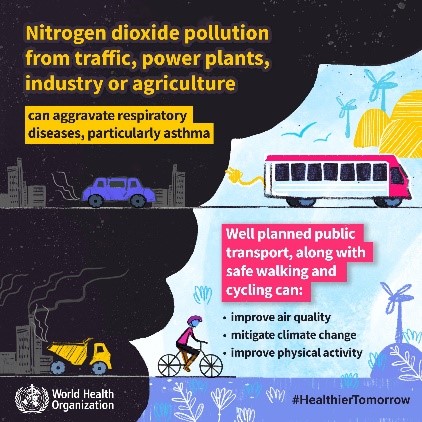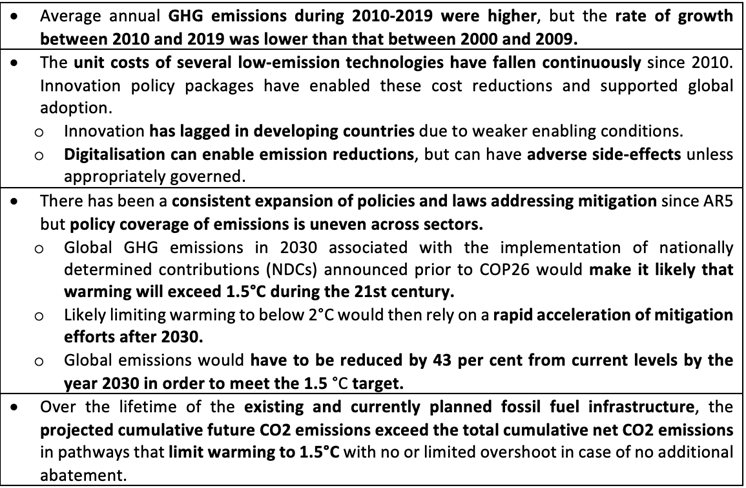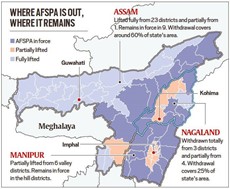Thursday, 7th April 2022
Electoral bonds - Edukemy Current Affairs
In News
The Chief Justice of India has recently assured petitioners that the court will take up for hearing a pending plea challenging the Electoral Bond Scheme, 2018.
About the News
- Two NGOs — Common Cause and Association for Democratic Reforms (ADR) — have challenged the Electoral Bond scheme, alleging that it is “distorting democracy”.
- In the past, the Election Commission of India had objected to the amendments in the Representation of the People (RP) Act, which exempt political parties from disclosing donations received through electoral bonds in their contribution reports filed mandatorily with the Election Commission every year.
What are electoral bonds?
- About: In an attempt to bring electoral funding more formal and transparent, the scheme of electoral bond was announced in the budget 2017 and was formally introduced in 2018. These are interest-free bearer instruments used to donate money anonymously to political parties.
- Important features:
- Anonymous: A bearer instrument does not carry any information about the buyer or payee and the holder of the instrument (which is the political party) is presumed to be its owner.
- Denominations: The bonds are sold in multiples of Rs 1,000, Rs 10,000, Rs 1 lakh, Rs 10 lakh, and Rs 1 crore.
- Cap on cash donation: The amount of money that a political party could accept in cash from anonymous sources has been reduced from Rs 20,000 to Rs 2,000.
- Designated bank: The State Bank of India (SBI) is the only bank authorised to sell them. SBI deposits bonds that a political party hasn’t enchased within 15 days into the Prime Minister’s Relief Fund.
- Freedom of choice: Donors can purchase and subsequently donate the bonds to their party of choice, which the party can then cash through its verified account within 15 days.
- Purchase limit: There is no limit on the number of bonds an individual or company can purchase.
- Restriction: The bonds can be bought only during specific windows of time and cannot be sold to foreign entities.
- Exemptions: Individuals, groups of individuals, NGOs, religious and other trusts are permitted to donate via electoral bonds without disclosing their details.
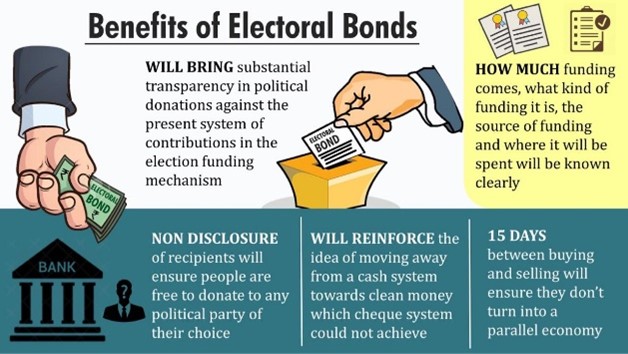
What are the major issues with electoral bonds scheme?
- Anonymity clause: The anonymity clause exempts political parties from disclosing donations received through electoral bonds which infringes the citizen’s ‘Right to Know’ and makes the political class even more unaccountable.
- Privacy risk: While electoral bonds provide no details to the citizens, the said anonymity does not apply to the government of the day, which can always access the donor details by demanding the data from the State Bank of India
- Misuse of taxpayer’s money: The printing of these bonds & SBI commission for facilitating the sale and purchase of the bonds is paid from the taxpayers’ money by the central government.
- Scope of Political vendetta: The fact that such bonds are sold via a government-owned bank (SBI) leaves the door open for the government to know exactly who is funding its opponents. This, in turn, allows the possibility for the government of the day to either extort money, especially from the big companies, or victimise them for not funding the ruling party — either way providing an unfair advantage to the party in power. Till now, more than 75 per cent of all electoral bonds have gone to the BJP, which is in power at the Centre.
- Skewed donations: Electoral bonds was introduced to allow common people to easily fund political parties of their choice but more than 90% of the bonds have been of the highest denomination (Rs 1 crore).
- Fear of corporate influence: Before the electoral bonds scheme was announced, there was a cap on how much a company could donate to a political party: 7.5 per cent of the average net profits of a company in the preceding three years. However, the government amended the Companies Act to remove this limit, opening the doors to unlimited funding by corporate India.
Sources:
Effective Plastic Waste Management
In News
The Ministry of Environment, Forest & Climate Change (MoEFCC) has recently awareness mascot ‘Prakriti’ and other green initiatives for effective plastic waste management.
About the News
- Active public participation is a pre-requisite to add momentum to India’s pledge of phasing out Single Use Plastics by 2022.
- Mascot ‘Prakriti’ has been launched to spread mass awareness about how adoption of small changes in our lifestyle can play a big role in environment sustainability. It also teaches about various efforts and initiative that the Ministry of Environment, Forest & Climate Change and Central Pollution Control Board (CPCB) have taken in order to ensure effective Plastic Waste Management (PWM).
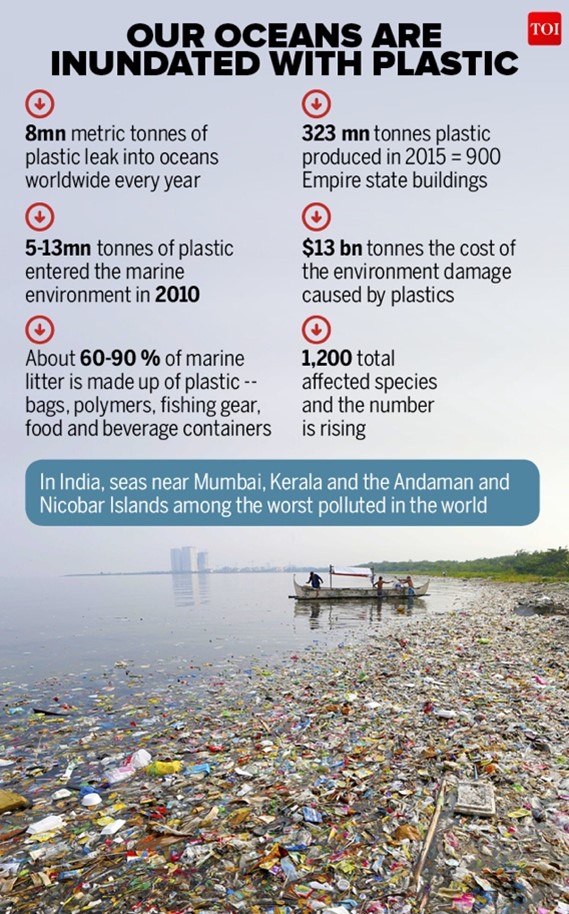
Green Initiatives for plastic waste management:
- In a drive toward global action on plastic pollution, India will implement a blanket ban on single-use plastic items such as earbuds with plastic sticks, plastic flags, plates, glasses, cutlery, etc to be banned from July 2022
- “Swachh Bharat Harit Bharat Green Pledge” had also been administered on same lines.
- India’s plastic waste management rules 2016 were amended banning the import of plastic waste SUVs with effect from July 2022 onward.
- National Dashboard on Elimination of Single Use Plastic and Plastic Waste Management (MoEFCC): This aims to connect all stakeholders including Central Ministries/ Departments, State/UT Governments, etc. through one platform and track status and progress made for elimination of single use plastic & effective management of plastic waste.
- Extended Producer Responsibility (EPR) Portal for Plastic Packaging (CPCB): This portal will look after tasks that will help in overall operational functions like improving accountability, traceability, transparency and facilitating ease of reporting compliance to EPR Obligations by Producers, Importers and Brand-owners.
- Mobile App for Single Use Plastics Grievance Redressal (CPCB): This app will allow citizens to check sale/usage/manufacturing of single use plastic in their region and tackle the plastic menace.
- Monitoring module for single use plastic (CPCB): This is for local bodies, State pollution control board/PCCs and CPCB, etc. to inventorize details of single use plastic production, its sale & usage, etc. in commercial establishments at district level, and on-ground enforcement of ban on single use plastics.
- Industrial production of Graphene from Waste Plastic (G B Pant NIHE & NRDC) will promote more industries to come forward to up cycle plastic waste.
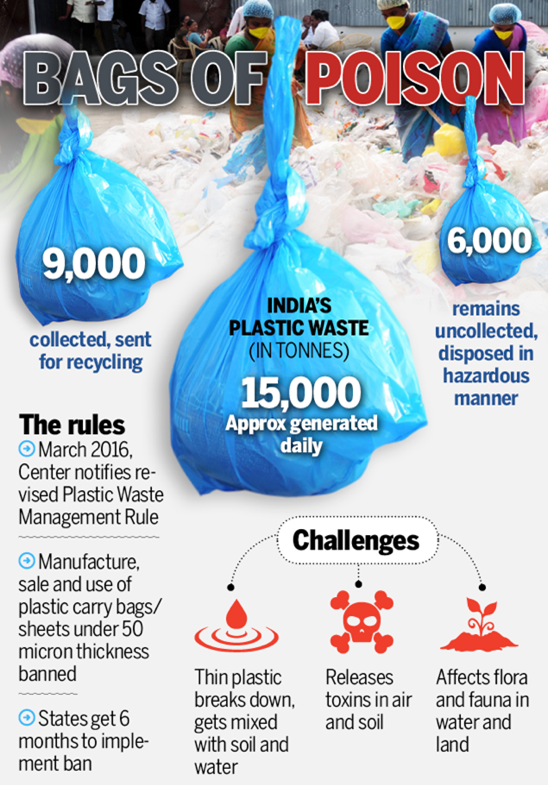
Source:
- Environment ministry launches ‘Prakriti’ & other Green Initiatives for Effective Plastic Waste Management
- Prakriti: Environment Minister launches green mascot to eliminate single-use plastic and effective waste management
Image source:
IMF Paper on Poverty in India
In News
IMF in a paper, ‘Pandemic, Poverty, and Inequality: Evidence from India’ has said that the safety net provided during pandemic in India prevented any sharp increase in extreme poverty levels during pandemic year 2020.
Findings of the Report
- Extreme poverty was as low as 0.8 per cent in the pre-pandemic year 2019, and food transfers were instrumental in ensuring that it remained at that low level in the pandemic year 2020.
- Extreme poverty was defined by World Bank as share of people living under $1.9 every day as per 2011 purchasing power parity terms.
- The low level of extreme poverty– around 0.8 % in both 2019 (0.76 %) and 2020 (0.86 %) – is suggestive of the need for the official poverty line to now be PPP $3.2.
- Real inequality, as measured by the Gini coefficient, has declined to near its lowest level reached in the last forty years — it was 0.284 in 1993-94 and in 2020-21 it reached 0.292.
- The incorporation of food subsidies into the calculation of poverty is that extreme poverty has stayed below (or equal to) 1 per cent for the last three years.
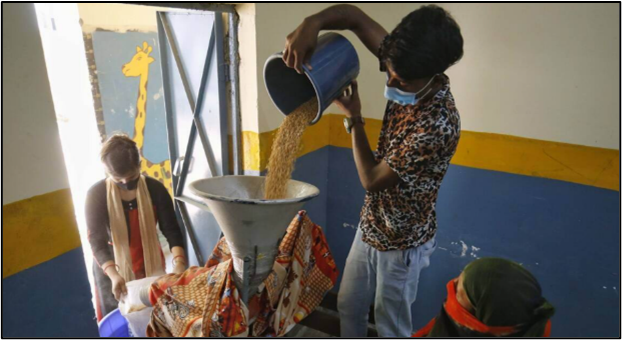
Incorporation of food subsidies in poverty calculation
- There are two aspects of a subsidy scheme (in-kind or cash transfers) which are relevant for any study on poverty alleviation:
- The effectiveness of targeting – i.e., how much of the food subsidy is obtained, or transferred to, the targeted population.
- Estimation of the “leakage” in the distribution.
- The expansion of food transfers and subsidies (as a proportion of the food consumption of the bottom two-thirds) makes it an important instrument for poverty alleviation.
- These transfers need to be incorporated into estimates of household consumption.
Conclusion
- Estimation of poverty in the absence of an official Consumption Expenditure Survey is critical for formulation of public policy.
- More so in the aftermath of the pandemic which is likely to have increased the poverty rates in most countries.
- The social safety net provided by the expansion of India’s food subsidy program absorbed a major part of the pandemic shock.
- The program provided insurance to the poor and prevented an increase in the prevalence of extreme poverty in India.
- The Pradhan Mantri Garib Kalyan Anna Yojana was launched in March 2020 and has been extended till September 2022.
- Under the PMGKAY, the Centre provides 5 kg food grains per month for free. The additional free grain is over and above the normal quota provided under the National Food Security Act (NFSA) at a subsidised rate of Rs 2-3 per kilogram.
- This illustrates the robustness of India’s social safety architecture as it withstood one of the world’s biggest exogenous income shocks.
Sources:
World Health Day
On April 7, 1948 World Health Organization was established. To commemorate this event, World Health Day is celebrated each year on April 7. Every year, a theme is chosen for the day, and this time, it is "Our Planet, Our Health". On World Health Day 2022, WHO will focus global attention on urgent actions needed to keep humans and the planet healthy and foster a movement to create societies focused on well-being. WHO added that around the world, 13 million deaths are caused due to avoidable environmental causes. India’s focus on affordable healthcare has ensured significant savings for the poor and middle class. At the same time we are strengthening our Ayush network to further boost overall wellness. Our Government’s efforts to enable study of medicine in local languages will give wings to the aspirations of countless youngsters.
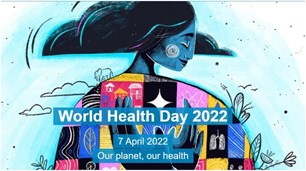
Sources:
RAMP programme for MSMEs
In News
The Union Cabinet has recently approved a World Bank-assisted RAMP programme, worth $808-million to improve the performance of micro, small, and medium enterprises (MSME).
About the News
- The Raising and Accelerating MSME Performance programme, or 'RAMP', programme, besides the national activities, is also expected to conduct "targeted activities in five 'first mover' states" of Gujarat, Maharashtra, Punjab, Rajasthan, and Tamil Nadu.
- RAMP was formulated and proposed by the Government of India, for strengthening MSMEs in line with the recommendations made by U K Sinha Committee, KV Kamath Committee and Economic Advisory Council to the Prime Minister (PMEAC).
- The programme which will commence in FY23, the government hopes to help all the enterprises that qualify as MSMEs of which nearly 5 lakh MSMEs will be "specifically targeted" for enhanced performance.
- Funds would flow through RAMP into the Ministry’s budget against Disbursement Linked Indicators (DLIs) to support ongoing MSME programmes, focusing on improving market access and competitiveness.
What is RAMP programme?
- About: It is a World Bank assisted Central Sector Scheme, supporting various Corona Virus Disease 2019 (COVID) Resilience and Recovery Interventions of the Ministry of Micro, Small and Medium Enterprises (MoMSME).
- Regulation: The overall monitoring and policy overview of RAMP would be done by an apex National MSME Council, headed by Minister for MSME, including representation from various Ministries and supported by a secretariat.
- Share: The $808 million corpus will have $500 million as a loan from the World Bank, while the remaining $308 million will come from the Central government.
- Tenure: The loan from the World Bank's International Bank for Reconstruction and Development is for 5 years, which includes a grace period of 5.5 years.
- Objective: The programme aims at improving access to market and credit
- strengthening institutions and governance at the Centre and State,
- improving Centre-State linkages and partnerships,
- addressing issues of delayed payments and greening of MSMEs.
- Strategic investment plans: Construction of Strategic Investment Plans, or SIPs for identification and mobilisation of MSMEs especially form priority sectors such as renewable energy, rural and non-farm business, wholesale and retail trade, village and cottage industries, and women enterprises, among others.
What are the Challenges faced by the MSME sector?
- Poor financial support: Lack of strong financial stimulus with concessional working capital loans from the government and financial institutes results in inadequate liquidity in business operations of MSMEs.
- Very few registrations: Most of the MSMEs are not registered anywhere mainly because of their small size. This apparent invisibility works against them in a time of crisis as it constrains a government’s ability to help them through wage subsidy or extra credit.
- Lack of formal banking support: According to a report by the International Finance Corporation (part of the World Bank), the formal banking system supplies less than one-third (or about Rs 11 lakh crore) of the credit MSME credit need that it can potentially fund.
- Bad loans: A key reason why banks dither from extending loans to MSMEs is the high ratio of bad loans with higher slippage for relatively bigger enterprises.
- Delays in payments: The other big issue plaguing the sector is the delays in payments to MSMEs — be it from their buyers (which includes the government also) or things like GST refunds etc.
- Impact of Covid-19: MSMEs were already struggling — in terms of declining revenues and capacity utilisation — in the lead-up to the Covid-19 crisis with most firms not having too much cash to wait out the crisis.
How will important RAMP programme help the MSME sector?
- Access to credit: The programme aims at improving access to market and credit, strengthening institutions and governance at the Centre and State, improving Centre-State linkages and partnerships, addressing issues of delayed payments and greening MSMEs.
- Capacity building: In addition to building the MoMSME’s capacity at the national level, the RAMP program will seek to scale up implementation capacity and MSME coverage in States.
- Addressing COVID challenges: RAMP programme will address the generic and COVID related challenges in the MSME sector by way of impact enhancement of existing MSME schemes including handholding, skill development, quality enrichment, technological upgradation, digitization, outreach and marketing promotion, amongst other things.
- Improving formalization: In States where the presence of MSMEs is on the lower side, the programme will usher in larger formalization resulting from the higher impact of the schemes covered under RAMP.
- Self-reliance: RAMP will complement the Atma Nirbhar Bharat mission by fostering innovation and enhancement in industry standards, practices and providing the necessary technological inputs to the MSMEs to make them competitive and self-reliant, enhancing exports, substituting imports, and promoting domestic manufacturing.
- Cradle of empowerment: RAMP programme, through enhanced collaboration with States, will be a job-enabler, market promoter, finance facilitator, and will support vulnerable sections and greening initiatives including expansion of the target market to include service sectors and an increase of about 70,500 women MSMEs.
- Strategic Investment Plans (SIPs): An important component of RAMP is the preparation of Strategic Investment Plans (SIPs), in which all states/UTs, will be invited. The SIPs would include an outreach plan for identification and mobilisation of MSMEs under RAMP, identify key constraints and gaps, set milestones and project the required budgets for interventions in priority sectors including renewable energy, rural & non-farm business, wholesale and retail trade, village and cottage industries, women enterprises etc.
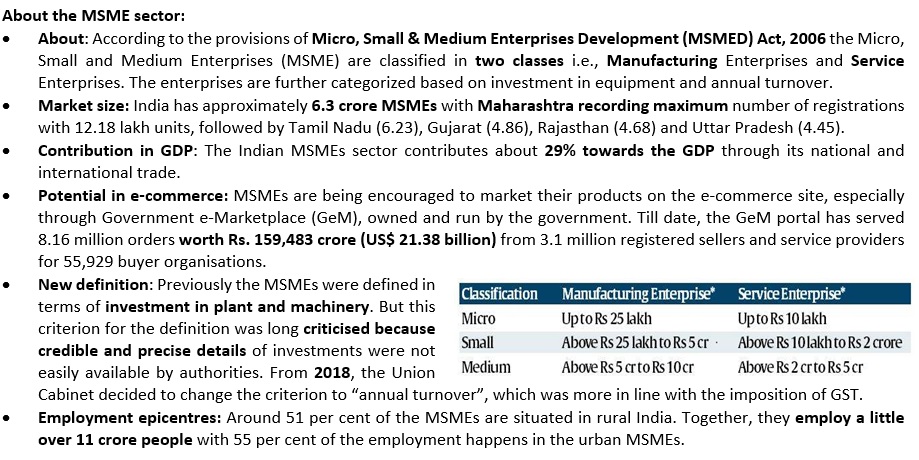
Government efforts for MSME
- Credit linked subsidy: The government launched the Special Credit Linked Capital Subsidy Scheme (SCLCSS) in 2021 for the services sector to help meet various technology requirements.
- SAMBHAV: Ministry of Micro, Small and Medium Enterprises launched SAMBHAV in 2021 which is a national-level awareness programme to push economic growth by promoting entrepreneurship and domestic manufacturing.
- India export initiative: Ministry of MSME has launched ‘India Export Initiative’ and ‘IndiaXports 2021 Portal’ to help exports reach its Rs. 2,928,000 crore (US$ 400 billion) target by the end of FY22 and further push it to Rs. 7,320,000 crore (US$ 1 trillion) by FY27.
- Support from Khadi: Khadi and Village Industries Commission (KVIC) has established the first ‘Silk Yarn Production Centre’ in Odisha to boost the local silk industry and generate employment. It has also launched SPIN (Strengthening the Potential of India) scheme and built a pottery cluster under SFURTI Scheme in Varanasi to support >1,100 individuals of the marginalised potters’
- Budgetary support: Budget allocation for MSMEs in FY22 is more than doubled to 15,700 crore (US$ 2.14 billion) vis-à-vis Rs. 7,572 crore (US$ 1.03 billion) in FY21.
- Loans: The government also announced Rs. 3 lakh crore (US$ 40.85 billion) collateral-free automatic loans for businesses.
- Emergency credit supports: The government has established funds worth Rs. 10,000 crore (US$ 1.36 billion) for ‘Guarantee Emergency Credit Line’ (GECL) facility to eligible MSME borrowers, giving a major boost to the sector.
Conclusion:
Programmes like RAMP will help scale up implementation capacity and MSME coverage in the country and will usher in larger formalisation resulting from the higher impact of the schemes covered under the programme. With the government of India vision of doubling the Indian economy to US$ 5 trillion in five years, there is need to crate career opportunities for the young population and MSMEs have the potential to serve as a key employment generator.
In order to achieve these targets, the government should invest in providing more back-end services to improve performance of the MSME sector as it supplies goods and services to big industrial enterprises. Lack of technology-based production activities and low investment in R&D activities are bottlenecks hindering the sector to become competent. Globally available technology could be subsidised by the government so that the product quality of MSME players can be improved using the existing resources. This also requires the help of academic institutions in the form of providing research and development (R&D) services for product innovation.
Question: Discuss how the RAMP programme would facilitate the growth of the MSME Sector.
Sources:
- Cabinet approves $808-million programme to improve MSME performance:
- Explained: Why are Medium, Small, Micro Enterprises worst hit by Covid-19 lockdown?:
- MSME Industry in India:
- Cabinet approves USD 808 million for “Raising and Accelerating MSME Performance”:
- Cabinet approves $808-million programme to improve MSME performance:
- Cabinet approves USD 808 million for “Raising and Accelerating MSME Performance”:
- Cabinet approves USD 808 million for scheme to improve MSME performance:
- In-Depth: How MSMEs can benefit from Rs 6,000-cr RAMP programme by World Bank, Govt of India:
- Cabinet approves USD 808 million for “Raising and Accelerating MSME Performance” scheme:
Pichwai paintings
This is image of a Pichwai Painting. The paintings, predominantly of Krishna with large eyes and a stocky build, earned their name because they were hung behind the deity ( peech-behind, vai-hang). Nathdwara, Rajsamand district in Rajasthan’s Mewar region, is pilgrim centre for Vaishnavites and birthplace of the Pichwai tradition of painting. Pichwai has come to encompass various themes – the Ras Lila, Jain folklore, the pantheon of Hindu gods, the Hanuman Chalisa, scenes from courtly life, and local flora and fauna – although it is Shrinathji as the cowherd, holding up Mount Govardhan, and appearing to his devotees that still holds forte. Primarily painted on cotton cloth, muslin or handmade paper, over time, Pichwai moved from temples to opulent drawing rooms and from the raag-bhog-shringar (music, food and jewellery for the deity) format to homespun vignettes of rural Rajasthan.
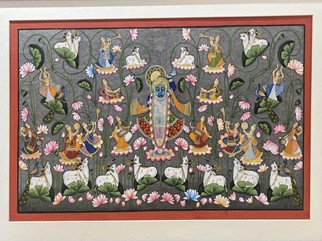
Source:
O. Henry Award
- Context: Bengali writer Amar Mitrahas won the O. Henry Award for his short story titled Gaonburo in Bangla and The Old Man of Kusumpur in English.
- The O. Henry Award is the only yearly award given to short stories of exceptional merit.
- The PEN/O. Henry Prize Stories is an annual collection of the year’s twenty best stories published in S. and Canadian magazines, written in English.
- The award is named after the American short-story writer Henry.
- The award was first presented in 1919 and funded by the Society of Arts and Sciences.
- Until 2002 there were first, second, and third prize winners.
- However, from 2003–2019 there were three jurors who each selected a short story of special interest or merit, the collection of which is called The PEN/O. Henry Prize Stories, and the original collection was called Prize Stories 1919: The O. Henry Memorial Awards.

Source:
Image source:
Central Tibetan Relief Committee (CTRC)
- Context: The Union government has recently extended the scheme to provide grants-in-aid to the Central Tibetan Relief Committee (CTRC) for another five years, up to 2025-26.
- The scheme provides for an annual grant of ₹8 crore to CTRC to meet the administrative expenses of Settlement Offices and social welfare expenses for Tibetan refugees staying in Tibetan settlements spread across 12 States/UTs in the country.
- The Dalai Lama’s Central Tibetan Relief Committee (CTRC) was formed and registered as Charitable Society under Indian Societies Registration Act XXI of 1860.
- It effectively acts as the Relief and Development Wing of Home Department, Central Tibetan Administration.
- All the CTRC activities are carried out with consent and support from Board of Directors and approval from TPiE (Tibetan Parliament in Exile).
- The Tibetan Parliament-in-Exile (TPiE) has its headquarters in Dharamsala, in the Kangra district of Himachal Pradesh according to which over 1 lakh Tibetans are settled across India.
- Major concentration of the Tibetan refugees is in Karnataka, Himachal Pradesh, Arunachal Pradesh, Uttarakhand, West Bengal and Jammu and Kashmir.
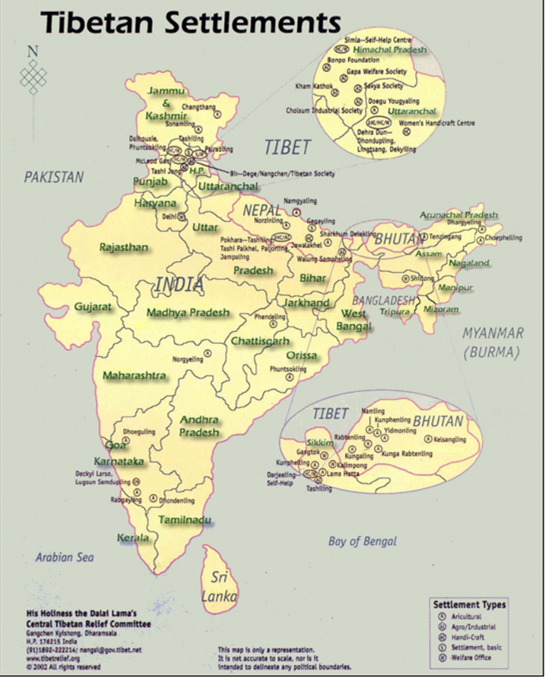
Source:
- Centre extends ₹40 crore relief to Dalai Lama’s Tibetan Committee upto 2025-26
- Relief package: Tranche 2 funds likely for over 1 lakh Tibetans in India
Image source:
India’s first steel slag road
- Context: Surat has become the first city in the country to get a processed steel slag (industrial waste) road.
- The six-lane public road is a kilometre-long stretch in Hazira industries, and is a joint-venture project by CSIR, Central Road Research Institute (CRRI), Union Ministry of Steel, NITI Ayog, and ArcelorMtttal-Nippon Steel (AM/NS), at Hazira.
- The construction of the road involves converting mounds of steel waste into steel slag aggregate.
- The construction cost of the processed steel slag road is 30% cheaper than roads built from natural aggregates and the thickness of the road is also 30% lesser than normal ones, while the durability is much longer due to the utilization of steel slag.
- Using processed steel slag in road construction paves the way for sustainable use of waste and reduces the reliance on perishable natural aggregates.
- It is also expected to reduce GHG emissions and carbon footprint in road construction activity and is in line with India’s commitment to the UNSDG-9 for building resilient infrastructure through inclusive and sustainable industrialization and green technologies.
- This project falls under the initiative of the Waste to Wealth and Clean India Campaign.

Source:
- Surat gets India’s first steel slag road: What is it, how is it different from regular ones?
- India gets its first steel slag road: Explaining what it is and how it’s a step toward sustainable infrastructure
Image source:
Vanniyar quota
- Context: The Supreme Court has recently struck down Tamil Nadu’s 10.5% Vanniyar quota.
- The apex court opined that the grant of 10.5% internal reservation to Vanniyakula Kshatriya community is violative of the fundamental rights of equality, non-discrimination and equal opportunity of 115 other most backward communities (MBCs) and de-notified communities (DNCs) in Tamil Nadu.
- Reservation in Tamil Nadu comprises 69% under a 1994 Act protected under the Ninth Schedule of the Constitution.
- Of the 69%, backward classes, including Christians and Muslims, get 30%; MBCs get 20%; Scheduled Castes 18%; and Scheduled Tribes 1%.
- The Special Reservation Act of 2021, which was enacted by the AIADMK government had scooped 10.5% of the total 20% MBC quota for Vanniyakula Kshatriyas alone, citing their "extreme backwardness".
- However, the court stated that the reservation afforded to the community under the 2021 Act was based on "antiquated data".
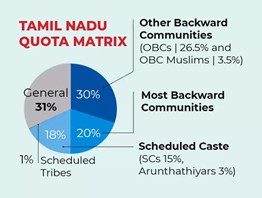
Source:
- Supreme Court strikes down Tamil Nadu’s 10.5% Vanniyar quota
- Supreme Court strikes down 10.5% Vanniyar quota in Tamil Nadu
Image source:
The hijab case and the struggle for the right to be and remain different: IE
Essence: The Karnataka High Court applied the doctrine of “qualified public space” in hijab case and banned hijab only in the classrooms and not in the school campus or other public spaces. It has invoked the fundamental duty of all citizens to ensure that “common brotherhood” is not affected by the hijab. Thus, it rejected non-uniformity in the matter of uniforms to prevent a sense of social separateness.
As per the author, the hijab issue is making cracks in constitutionalism by questioning whether uniformity prevails over rights to dignity, privacy, and the right to be and to remain different? is there another way to foster engagement with the foundational values of dignity, equality, and liberty? and is respect for dress as symbolic speech not enshrined in the right to free speech and expression?
As per the author, the Supreme Court should fast-track the hearing as delay would give an agenda for certain organisations to threaten the roots of public order, and unity and integrity of India and may lead to demonstrations in public spaces.
Why should you read this article?
- To know about the application of the doctrine of “qualified public space” by the Karnataka High Court to the hijab case.
- To know about the authors opinion about how hijab issue is questioning constitutionalism.
- To know about the authors opinion about why this issue needs swift resolution by the Supreme Court.
Source:
Repairing the complex India Nepal Relationship: TH
Essence: The editorial discusses Nepal’s relationships with important partners- India, China and USA and their stakes in Nepal. India and Nepal seek cross-border rail link, joint development power generation projects with transmission linkages across the border, power purchase agreements, induction into International Solar Alliance and supply of petroleum products to Nepal. Extending the pre-independence treaty between Nepal and India, Nepali nationals can travel to India without visa and avail the right to work. Few lows in relationship have been the alleged Indian attempt to influence the Nepali constitution, de-facto trade blockade in 2015, demonetization currency exchange, and age old Kalapani and Susta border issue.
China’s prime interest in Nepal had been keeping a control of Tibetan refugees in the nation, but now has expanded to increasing FDIs, proving transit transportation (4 sea, 3 land ports), expansion of airports, and providing developmental assistance. Lately, USA and Nepal concluded the agreement to grant finances for high voltage transmission line and maintenance of highways.
What’s required in today’s India diplomacy is not to compete with other nations but engage productively with Nepal, be a generous and sensitive partner and engage with Nepal at track 1.5 and 2 level diplomacy.
Why should you read this article?
- To know about Nepal’s relationship and engagement with India.
- To understand how India should approach future engagements with Nepal.
Source:
The unequal impact of oil price shock: IE
Essence: Large and small firms are likely to be impacted differently by current oil price shocks. It can be said with confidence because during the pandemic while large firms widened their market share, small firms struggled to even stay afloat because of rising input costs. This differential impact was reflected in their employees also. The resilience of large firms was largely because of their ability to cut costs, get cheaper money because of the lower interest rate environment and pricing power.
Absence of reliable data to track informal sectors and their employees compounded their misery. The author suggests that an expansionary fiscal policy to focus on growth and tight monetary policy to target inflation will be an appropriate strategy to ameliorate the situation created by oil shock while hand holding small firms.
Why should you read this article?
- To understand how market shocks like increase in oil price or lockdown affect large and small firms differently.
- To understand the impact of such shocks on formal and informal sector employees.
- To understand options with government to deal with the situation.
Source:
Rescuing Child Labourers
Background:
Access to education is the fundamental right of any child. But, this right is compromised for many due to financial constrains, poverty, social norms, etc.
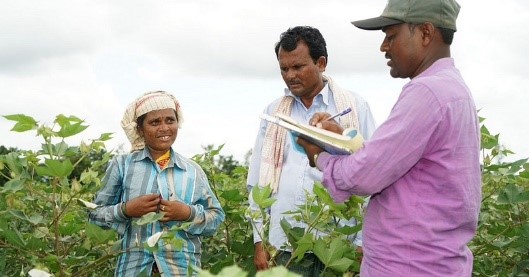
How Child Labour are rescued in the Cotton fields?
- When the company Bayer entered into business of cottonseeds in 2002, it witnessed that the production process of hybrid cottonseed was complex, tedious and labour-intensive. There was also prevalence of child labour in the supply chain operations.
- To aid them in their work, most farmers hired children as extra labourers in these fields, which was a direct violation of the company’s No Child Labour Policy.
- Bayer launched a programme Child Care Program (CCP) in the cotton farms that are associated with the company in five States i.e., Karnataka, Andhra Pradesh, Gujarat, Tamil Nadu and Maharashtra.
- From spreading awareness and sensitizing farmers, monitoring fields for rescue, initiating a contractual ban on child labour, incentivising those who refrained from it to implementing penalties upon violation, CCP began to zero down on this problem with a multi-layered approach.
- After their relentless efforts, the incidence rates of child labour in Bayer’s cottonseed production have substantially dropped to a virtual level of zero.
Quote: Child labour and poverty are inevitably bound together and if you continue to use the labour of children as the treatment for the social disease of poverty, you will have both poverty and child labour to the end of time.- Grace Abbott
Source:
Share the article
Get Latest Updates on Offers, Event dates, and free Mentorship sessions.

Get in touch with our Expert Academic Counsellors 👋
FAQs
UPSC Daily Current Affairs focuses on learning current events on a daily basis. An aspirant needs to study regular and updated information about current events, news, and relevant topics that are important for UPSC aspirants. It covers national and international affairs, government policies, socio-economic issues, science and technology advancements, and more.
UPSC Daily Current Affairs provides aspirants with a concise and comprehensive overview of the latest happenings and developments across various fields. It helps aspirants stay updated with current affairs and provides them with valuable insights and analysis, which are essential for answering questions in the UPSC examinations. It enhances their knowledge, analytical skills, and ability to connect current affairs with the UPSC syllabus.
UPSC Daily Current Affairs covers a wide range of topics, including politics, economics, science and technology, environment, social issues, governance, international relations, and more. It offers news summaries, in-depth analyses, editorials, opinion pieces, and relevant study materials. It also provides practice questions and quizzes to help aspirants test their understanding of current affairs.
Edukemy's UPSC Daily Current Affairs can be accessed through:
- UPSC Daily Current Affairs can be accessed through Current Affairs tab at the top of the Main Page of Edukemy.
- Edukemy Mobile app: The Daily Current Affairs can also be access through Edukemy Mobile App.
- Social media: Follow Edukemy’s official social media accounts or pages that provide UPSC Daily Current Affairs updates, including Facebook, Twitter, or Telegram channels.

